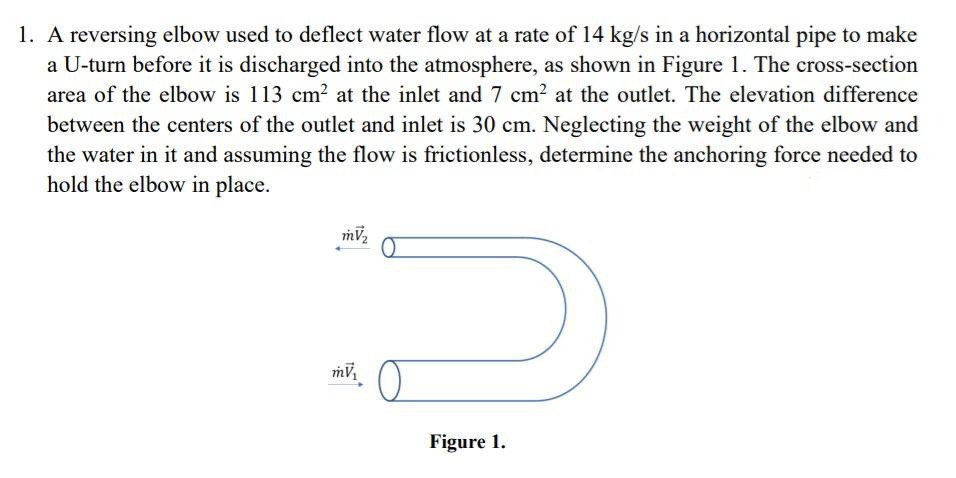A reversing elbow used to deflect water flow at a rate of 14 kg/s in a horizontal pipe to make a U-turn before it is discharged into the atmosphere, as shown in Figure 1. The cross-section area of the elbow is 113 cm² at the inlet and 7 cm² at the outlet. The elevation difference between the centers of the outlet and inlet is 30 cm. Neglecting the weight of the elbow and the water in it and assuming the flow is frictionless, determine the anchoring force needed to hold the elbow in place.
A reversing elbow used to deflect water flow at a rate of 14 kg/s in a horizontal pipe to make a U-turn before it is discharged into the atmosphere, as shown in Figure 1. The cross-section area of the elbow is 113 cm² at the inlet and 7 cm² at the outlet. The elevation difference between the centers of the outlet and inlet is 30 cm. Neglecting the weight of the elbow and the water in it and assuming the flow is frictionless, determine the anchoring force needed to hold the elbow in place.
Elements Of Electromagnetics
7th Edition
ISBN:9780190698614
Author:Sadiku, Matthew N. O.
Publisher:Sadiku, Matthew N. O.
ChapterMA: Math Assessment
Section: Chapter Questions
Problem 1.1MA
Related questions
Question

Transcribed Image Text:1. A reversing elbow used to deflect water flow at a rate of 14 kg/s in a horizontal pipe to make
a U-turn before it is discharged into the atmosphere, as shown in Figure 1. The cross-section
area of the elbow is 113 cm² at the inlet and 7 cm² at the outlet. The elevation difference
between the centers of the outlet and inlet is 30 cm. Neglecting the weight of the elbow and
the water in it and assuming the flow is frictionless, determine the anchoring force needed to
hold the elbow in place.
mv₂
mV₁
O
Figure 1.
Expert Solution
This question has been solved!
Explore an expertly crafted, step-by-step solution for a thorough understanding of key concepts.
This is a popular solution!
Trending now
This is a popular solution!
Step by step
Solved in 3 steps with 3 images

Knowledge Booster
Learn more about
Need a deep-dive on the concept behind this application? Look no further. Learn more about this topic, mechanical-engineering and related others by exploring similar questions and additional content below.Recommended textbooks for you

Elements Of Electromagnetics
Mechanical Engineering
ISBN:
9780190698614
Author:
Sadiku, Matthew N. O.
Publisher:
Oxford University Press

Mechanics of Materials (10th Edition)
Mechanical Engineering
ISBN:
9780134319650
Author:
Russell C. Hibbeler
Publisher:
PEARSON

Thermodynamics: An Engineering Approach
Mechanical Engineering
ISBN:
9781259822674
Author:
Yunus A. Cengel Dr., Michael A. Boles
Publisher:
McGraw-Hill Education

Elements Of Electromagnetics
Mechanical Engineering
ISBN:
9780190698614
Author:
Sadiku, Matthew N. O.
Publisher:
Oxford University Press

Mechanics of Materials (10th Edition)
Mechanical Engineering
ISBN:
9780134319650
Author:
Russell C. Hibbeler
Publisher:
PEARSON

Thermodynamics: An Engineering Approach
Mechanical Engineering
ISBN:
9781259822674
Author:
Yunus A. Cengel Dr., Michael A. Boles
Publisher:
McGraw-Hill Education

Control Systems Engineering
Mechanical Engineering
ISBN:
9781118170519
Author:
Norman S. Nise
Publisher:
WILEY

Mechanics of Materials (MindTap Course List)
Mechanical Engineering
ISBN:
9781337093347
Author:
Barry J. Goodno, James M. Gere
Publisher:
Cengage Learning

Engineering Mechanics: Statics
Mechanical Engineering
ISBN:
9781118807330
Author:
James L. Meriam, L. G. Kraige, J. N. Bolton
Publisher:
WILEY